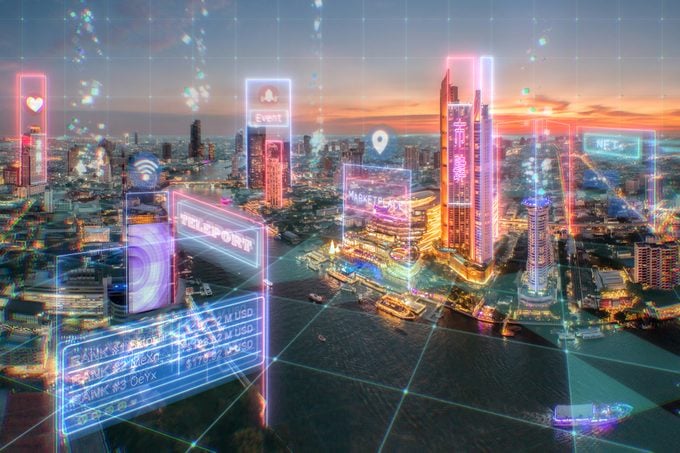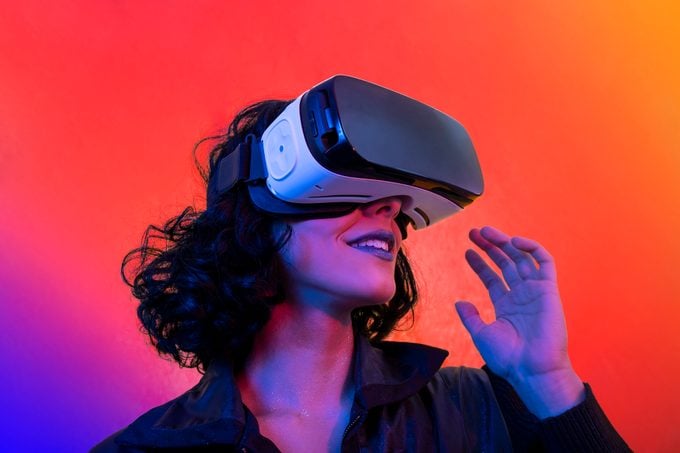What Is the Metaverse, Exactly?
Updated: Feb. 01, 2024

Our complete guide to the metaverse will teach you everything you need to know about the technology you haven't heard of—but will soon change the world
The Reader’s Digest Version:
- The metaverse uses virtual reality and augmented reality to virtually transport you to a different place, or world.
- Accessing the metaverse is as simple as putting on a virtual reality headset and holding a set of controllers.
- While its biggest use at present is gaming, the metaverse will increasingly be used for shopping, education, job training, doctor’s appointments and socializing.
- There are a number of ways to make money in the metaverse, including buying and selling virtual real estate, trading cryptocurrency and NFTs, and selling goods/products, both real-world and virtual.
- Experts predict interactions in the metaverse will become commonplace in the next five to ten years.
A virtual world so compelling that people would rather “live” there than in reality—in the 1990s novel Snow Crash, it’s the Metaverse; in the 2000s Matrix movies, it’s the Matrix; and in the 2010s novel and movie Ready Player One, it’s OASIS. But whatever you call it, humans have been imagining this type of digital, all-consuming, futuristic realm for decades. Now, in the 2020s, we’re all the way back to calling it the metaverse, and it’s feeling more real than ever. But what is the metaverse, exactly? And what is VR (aka virtual reality), and how are they different?
At the moment, the term metaverse is a bit of a catch-all, explains Chris Madsen, senior engineer for Engage, a professional virtual reality and augmented reality (AR) platform used by many Fortune 500 companies. “Loosely speaking, you can think of the metaverse as the ‘universe’ of the virtual world,” he says. The metaverse is founded on the internet but is much more expansive than that technology. It isn’t owned by a single country or corporation.
Still having trouble wrapping your head around the concept? Think of it this way: The internet is the “world wide web” and is used for a vast array of different things, ranging from shopping and socializing to banking and entertainment. Practically everything that exists in the real world can now be found on the internet and eventually will also be “in” the metaverse.
Now, think back to the very beginning—the early Wild West days of the internet in the ’90s, when websites had either limited graphics or neon-colored text that scrolled by too quickly and crashed more often than not—and that’s where the metaverse is right now, says James Shannon, CEO and co-founder of XONE, a mobile augmented reality social network. But it’s evolving faster than you realize.
Never heard of the metaverse? You’re not alone; nearly 70% of Reader’s Digest readers polled in our Future of Tech survey said they aren’t familiar at all with the metaverse, and another 27% said they are only somewhat familiar. Don’t worry, we’ve got you covered with the answer to “What is the metaverse?” along with the underlying technologies—start with our NFT explainer and Web3 explainer.
On This Page
What does metaverse mean?

There’s a reason for the confusion: There isn’t one simple definition of the metaverse, says Madsen. Most people think of it generally as a virtual place where people, companies or other entities can create their own virtual worlds. It’s an “extended reality,” which uses virtual reality and augmented reality to take you out of your real world and into a different, virtual world, Madsen explains.
But the word is currently being used in many different contexts in wildly different ways. For instance, the Forbes Technology Council gave it an expansive definition as a Marvel-esque “multiverse of metaverses.”
For his part, Meta/Facebook CEO Mark Zuckerberg famously defined the metaverse as not a place at all, virtual or otherwise, but a time. “One definition of this [the metaverse] is it’s about a time when basically immersive digital worlds become the primary way that we live our lives and spend our time,” he said in a February 2022 interview.
(And don’t be confused: Despite Facebook rebranding in Oct. 2021 to Meta Platforms Inc., or just Meta for short, Meta isn’t the entire metaverse, just like Facebook isn’t the entire internet.)
Remember, “internet” didn’t mean much at first either, and eventually people settled on a universal understanding of the term. Over time the same will happen with metaverse (or whatever term becomes the popular choice), says Shannon.
Books and movies about the metaverse
What is the purpose of the metaverse?
The goal is that, eventually, anything you can do in the real world will have a virtual counterpart in the metaverse. However, it isn’t about replacing reality (a la the Matrix or Ready Player One) but working in sync with your real life, to enhance it, says Madsen.
Currently, the metaverse has a narrower scope based on the limits of the underlying technology, but there are still plenty of exciting things happening there, says Madsen. These include:
Gaming

Currently the most popular use of virtual reality, games use the metaverse to create an immersive gaming experience. Computer and console-based games like World of Warcraft and Roblox are creating metaverse games, part of the future of immersive technology.
Shopping
The opportunity to make money via marketing and increased sales is what entices most companies to the metaverse, and it’s where lots of the tech development is currently focused. The goal is to provide a shopping experience even better than you could get in real life. For instance, you might try on clothing using a digital avatar that matches your real-world dimensions, letting you try on multiple dresses for that upcoming wedding without ever leaving home or messing up your hair. Similarly, you can go through a virtual Walmart, selecting items and adding them to your cart in a way that is clearer and faster than either a real-world shopping trip or the current online click-through experience. The physical goods are then delivered to your home.
Companies including Gucci (via The Sandbox), Ralph Lauren and Nike (via Roblox) and Balenciaga and Moncler (via Fortnite, see below) have all dabbled with storefronts in the metaverse. While they aren’t fully functional stores, the goal is to offer both physical goods and digital-only offerings, like NFTs, avatars and virtual clothing.
View this post on Instagram
Job training
From teaching doctors how to perform surgery to the requisite safety trainings for new hires, the metaverse offers an easier and safer way to educate people. Here, you can practice first aid skills, learn complicated machinery and protocols, and take classes at a convenient time and place—and without endangering any real human bodies.
Education
The future of university classrooms lies in the metaverse, where anyone can learn cutting-edge information from the best professors around the world, says Madsen. In January 2022, Stanford University launched “Communication 166/266 Virtual People,” its first class hosted in the metaverse (students participate with Oculus 2 headsets), and other academic institutions are following suit. As of this writing, “metaversities” include Morehouse, Fisk, New Mexico State University, South Dakota State University, Florida A&M University, West Virginia University and the University of Maryland Global Campus.
Working remotely
Think Zoom is convenient? What if you could “appear” in a meeting room to collaborate with your colleagues—without ever leaving your home (or your pajamas)? Virtual workspaces are cheaper and more accessible, and will eventually become ubiquitous.
Doctor’s appointments
Anything that doesn’t require directly touching the body, from therapy to medication checks, could be done in virtual doctors’ offices.
Travel
Check out museums across the world, hike through rainforests without damaging wildlife or even take part in space tourism via virtual travel portals without having to buy an expensive ticket.
Social activities
Social media goes next level in the metaverse, says Shannon. Not only can you share information, pictures and videos, you can play group games, chat in VR rooms or even go on a date.
Entertainment
In addition to games, the metaverse is perfect for other types of entertainment. For instance, virtual movie theaters provide a much better experience than home TVs provide. Big names including Ariana Grande, The Chainsmokers and Travis Scott have all hosted digital concerts in the metaverse—where people got a much better view than the nosebleed seats they might have had in real life, plus digital extras that made the concerts more immersive. But Madsen’s favorite? Virtual mini golf with friends!
How to access the metaverse

Accessing the metaverse requires a combination of specialized hardware (phones, computers, headsets, 3D screens, gloves, etc.) and software (games, programs, etc.). What you need depends on exactly what you want to do. For instance, to play most popular VR games, you’ll need a VR headset and controllers. Headsets range from $30 cardboard versions to $1,000 high-end sets that come with multiple cameras and sensory outputs.
There is no unified metaverse, so each company is developing its own platform, headsets and other technology. Currently, major players include Meta, NVIDIA, Epic Games, Microsoft, Apple, Decentraland, Roblox Corporation, Unity Software, Snapchat, The Sandbox and Amazon.
The most popular platforms for accessing the metaverse include Meta, Oculus (now owned by Meta), Sony, HTC, Pico, Valve and Samsung.
That’s not the only way to log in though, says Madsen. The portions of the metaverse featuring augmented reality come to you, usually via your phone screen and camera—think a Snapchat filter that puts a crawling tarantula on your face or the Pokémon Go AR game that was popular a few years back.
In the future, accessing the metaverse will be done with a simple pair of eyeglasses, Madsen predicts.
How does the metaverse work?
The technology underpinning the metaverse is cobbled together from other technologies, including virtual reality, blockchain and Web 3 (along with more mature programming tech that underpins the internet). Blockchain is a way of storing chunks of data in “blocks,” which are linked together into a chain based on relevance. Blockchain databases provide a way to share data while guaranteeing fidelity and security, which is why they are such a critical component of cryptocurrency. Blockchain provides the building blocks for Web 3, the newest iteration of the internet that provides the framework for extended reality. Last, virtual reality builds on these technologies to simulate a real-world experience. Most VR software is based on a “virtual world generator,” which is made using a software development kit from a specific VR headset vendor. This kit provides the basic programs, drivers, data and graphic-rendering libraries.
How to make money in the metaverse

As with most technology, the crucial question is how to monetize the experience. The metaverse offers most of the options available in the real world, plus a few that are only available virtually.
Buying and selling virtual land
Just like people are snapping up land in the real world, investors are buying up digital spaces, including “locations.” Buying virtual real estate requires using virtual currency, aka cryptocurrency, to buy directly from a virtual developer. Currently, the two most popular platforms are The Sandbox and Decentraland, each of which has its own currency (SAND and MANA, respectively).
Trading crypto
You can make money trading cryptocurrencies, similar to how you can make money investing in stocks—it requires upfront (real) capital and a high tolerance for risk.
Trading NFTs
Non-fungible tokens are a digital security stored in a blockchain that represents a real asset, usually music, art (especially popular memes), in-game items and videos. Creating, buying and selling NFTs can be a lucrative business if you can predict what will be popular. Keep in mind that NFTs are potentially bad for the environment.
Selling real-world goods virtually
Virtual storefronts for real products are already live for some stores, like the aforementioned Walmart. While there are currently a lot of kinks, the goal is to eventually provide a virtual experience that is better than a real one. Virtual purchases will deliver real goods.
Other ways to make money
New financial opportunities are popping up as the technology evolves. Some possibilities include hosting metaverse events, selling virtual items like digital clothing or hairstyles for avatars, selling metaverse-specific services and trading metaverse tokens.
Examples of the metaverse
The metaverse is already all around you if you know where to look for it. Second Life, the popular computer game that simulates real life, is a natural fit for the metaverse and is quickly gaining popularity. Other games, including those mainly popular with the younger generation, like Fortnite, Minecraft and Roblox, are also big in the virtual sphere; by some estimates, nearly 100 million people log on to these games daily. First-person shooter and quest games become even more realistic and immersive in the metaverse.
Meta Horizons is like Facebook … on steroids. The social platform is aiming to be the one-stop shop for digital socializing, communications and living.
It doesn’t have to be that intense though, adds Madsen. Even using a stargazing app or a voice-changing filter on your phone is engaging with the metaverse in a small way. “We all do it a lot more than we realize,” he says. “Anytime you’re using a virtual enhancement in your life, it’s a small part of extended reality or the metaverse.”
Is the metaverse safe?

All the safety concerns that exist about the internet are magnified by virtual reality—the more real the environment, the more real-feeling the scams—along with some new ones particular to the metaverse, says Madsen.
Privacy
Blockchain technology is built to be a far more secure and private way to share information, but every tech has its flaws. In addition, laws regarding digital privacy rights are in flux, and there are many questions about the legality of data privacy in the metaverse.
Accessibility
Human bodies aren’t equipped on their own to access the metaverse, as it requires hardware, software and knowledge—all of which can be very expensive for individuals to get. In addition, some countries or regions would need to install expensive and complicated infrastructure to enhance data storage and data processing speeds. This could create a volatile system of technological haves and have-nots.
Health
Virtual reality has a powerful effect on the brain’s behavior, and this raises real-world concerns about physical and mental health, says Madsen. There are the obvious risks of physically injuring yourself from tripping or falling, but people are also reporting headaches, vertigo, muscle soreness and vision issues. Plus, people who are immersed in digital worlds often are doing so at the expense of exercising, breathing fresh air and socializing physically.
The more subtle health risks are mental. Because VR provides a much more realistic experience than watching something on a computer screen, the emotional and mental impacts are more intense. Watching a horror movie in VR, say, could cause real trauma, Madsen says. Not to mention that all the downsides of the current internet are magnified in VR, like violent pornography, the black market, sex trafficking and criminal activities.
When will the metaverse come out?

The metaverse already exists in theory and in many practical ways, but expect the technology to explode over the next five to ten years, predicts Madsen. Wearables, like VR headsets, will become comfortable, portable and more powerful. Software will become more realistic, heading toward “fully immersive” experiences.
This technology will have huge impacts on how people work (physical proximity will be a much smaller priority, but people may be required to be on the clock, around the clock), how people play (games won’t be limited by physical constraints like gravity), how people socialize (being present as a hologram at a birthday party would be much better than a video chat) and, most important, how we consume information. If we live in a “post-truth” society now, imagine what it will be like when lies are even more realistic and believable and deepfakes aren’t just 2D.
The future is now
Remember that feeling in the ’90s, when the internet was brand-new and anything felt possible? Today’s metaverse has all that hope and opportunity, but on a much grander scale. For instance, virtual real estate is already big business: Less than a year ago, a small plot of virtual land that sold on Decentraland for $1,000 is now worth $13,000.
“It’s a really exciting time, because just like the internet did in the ’90s, the metaverse is going to revolutionize the world in ways we can’t even imagine yet,” says Shannon.
Sources:
- Chris Madsen, senior engineer for Engage, a professional virtual reality and augmented reality platform used by many Fortune 500 companies
- James Shannon, CEO and co-founder of XONE, a mobile augmented reality social network
- Lex Fridman Podcast #267: “Mark Zuckerberg: Meta, Facebook, Instagram, and the Metaverse”






